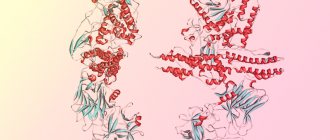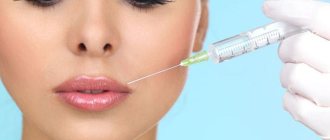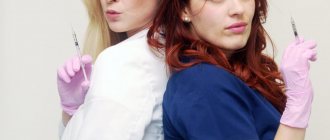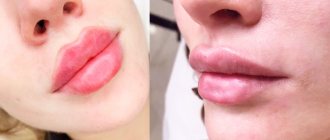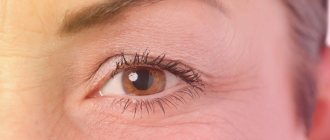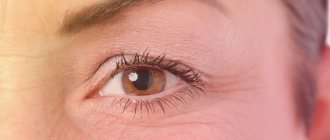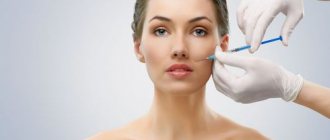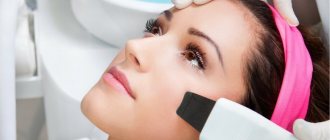What are Botox injections?
During a botulinum therapy session, the cosmetologist injects botulinum toxin into the facial muscles. The most popular of them, Botox, is injected into the muscles of the upper face.
Botox injections are good for getting rid of facial wrinkles. The active component of the drug blocks the activity of facial muscles, as a result of which wrinkles are smoothed out. The less mobile the facial muscles are, the less deep the facial wrinkles become.
Botulinum toxin products are also used to treat hyperhidrosis and excessive sweating. Botox is not suitable for this purpose because it concentrates in the injection area and does not spread to nearby tissues. Drugs that are more prone to diffusion are injected into the armpits, palms and feet - hyperhidrosis is especially pronounced in these areas.
The session takes about 20 minutes and in most cases is performed without anesthesia - there is no pain, and therefore no anesthesia is required. After 2-7 days, the first results are noticeable, but at this time the facial tissues are most vulnerable. Any careless influence leads to swelling and even impaired facial expressions.
Alcohol and Botox analogues
Any drug containing botulinum toxin cannot be combined with alcohol. After all, there are no fundamental differences in the compositions; there is only one active ingredient and various additional components.
There is a theory that xeomin has a more pronounced effect than drugs based on a neurotoxin and auxiliary proteins. Since xeomin has a low molecular weight, it is mobile and has the ability to spread. Under the influence of alcohol, its diffusion can be significantly enhanced.
Buyanov Sergey Yurievich (Expert Doctor):
Theoretically, botulinum toxin, bound to proteins, is most protected from interaction with alcohol, since it moves specifically to the nerve synapses, and only after that is released from the “shell”. No research has been conducted in this area and is unlikely to be expected in the future, so it is not recommended to take risks and test the effects of alcohol after a botulinum toxin injection for up to two weeks.
Photos before and after
Preparing for the session
Before a botulinum therapy session, careful preparation is required:
- do not drink alcohol the day before the session;
- 3 days in advance – stop taking antibiotics;
- a week before - stop taking medications that reduce blood clotting;
- on the day of the procedure - do not play sports, do not visit a massage therapist, do not swim or tilt your head for a long time, do not apply cream to your facial skin.
Foods high in salt and spices retain water in the body. This diet leads to swelling. If you are planning Botox injections, you should avoid salty and spicy foods.
Botulinum toxin can manifest itself in unexpected ways, therefore, if the patient has never attended such procedures, allergy tests are required. Botox is not a hypoallergenic drug; an allergic reaction may occur.
What to do if you couldn't resist
If an alcohol-containing drink was drunk before the injection was administered, it is recommended to contact a beauty salon and reschedule the visit and injection to another day. If alcohol was taken after rejuvenation, then you can only hope that the Botox “will not float” and the result will not be terrible.
If facial deformation appears, you need to make an appointment with a cosmetologist and undergo a course of correction. You can't hesitate. No matter how much time passes, the imperfections that appear on the face will not simply “resolve.”
Restrictions after botulinum therapy
Here are some basic recommendations after botulinum therapy.
Be in a vertical position only
For 5 hours after Botox injections, you should not lie down or bend over. Blood rushes to the head in a horizontal position, because of this, metabolism accelerates, botulinum toxin is eliminated from the body faster. Improper distribution of botulinum leads to loss of effect.
…
Don't drink alcohol
Alcoholic drinks dilate blood vessels and accelerate blood flow, causing excess movement of botulinum toxin. The movement of botulinum toxin through facial tissues is fraught with numbness, drooping eyelids and problems with articulation. Possible formation of hematomas.
In the first 7-10 days after the session, drinking alcohol is prohibited!
…
Do not visit saunas and baths
High temperatures cause capillaries to expand and provoke the removal of Botox from the body and its migration through facial tissues. You can go to the bathhouse or sauna only after complete recovery. During the first day after the session, hot water is also dangerous for patients. Postpone going to the sauna or bathhouse for at least 2 weeks.
…
Don't play sports
During intense exercise, blood flow accelerates - this can be dangerous immediately after Botox injections. For two days, patients are not allowed to engage in any sports, jogging, or fitness. Loads with an inclination are especially contraindicated. Dancing and martial arts are also prohibited.
…
Do not undergo cosmetic procedures
There are a number of cosmetic interventions that are compatible with Botox injections, but they can only be used after the body has fully recovered from the previous session, that is, after about 3 weeks. For 3 days, massage, masks, peelings, hardware treatments, etc. are prohibited.
Contraindications
- The patient must be between 18 and 60 years of age. This is the ideal time for Botox to work well. After 60, its effectiveness noticeably decreases, because it is not able to change all natural changes in muscle elasticity, especially those caused by age.
- Oncological, respiratory or allergic diseases. You can get a complete and accurate list from a cosmetologist during a consultation.
- Experts give different answers as to why you should not drink alcohol after lip augmentation, but most agree that it is not prohibited, it is simply not recommended. This will not spoil the quality of the injection, but will create additional stress for the body.
- The timing of the injections must be timed so that there is no need to take antibiotics before the procedure. This is necessary so that its effectiveness does not decrease. Otherwise, Botox may not work as well as it should, and you may not be happy with the result.
- Don't overexert yourself before the procedure. Skip the gym and don't be a hero when leaving the store. Physical fatigue will not improve the quality of the injection.
- It is better not to do beauty injections during pregnancy and while breastfeeding. The effect of injections on the fetus and child has not yet been fully studied. It is better not to risk the baby’s health and refrain from going to the cosmetologist at this time.
- Diseases of the liver, kidneys.
- It is better not to do Botox if you have your period, because it will put too much stress on the body, and it will be harder for you to tolerate the procedure.
Compatibility of Botox with other procedures
Botox injections are a fairly safe intervention. They are combined with other cosmetology techniques:
- Fillers. The drugs complement each other's effect - Botox smooths out expression wrinkles in the upper part of the face, and hyaluronic acid fills deep nasolabial folds and scars.
- Hardware procedures. They perfectly complement botulinum therapy, but a pause between sessions of 3-5 weeks is required.
- Chemical peeling. The result of peeling will be better if it is performed after complete recovery from botulinum therapy. Smooth skin is easier to peel. It will get rid of age spots and scars and complement the effect of Botox injections.
- Plastic surgery. A month after botulinum toxin injection, blepharoplasty can be done.
Mechanism of action of Botox
Botox and its analogues are based on botulinum toxin type A, a substance widely used not only for aesthetic purposes. It is widely used for the correction of neurological conditions during surgical operations. The drug is obtained with the participation of the bacterium Clostridium botulinum, which is the cause of a dangerous disease - botulism. Once in the body, it leads to muscle paralysis. Due to its low concentration and injection into targeted areas, the toxin helps to cope with a variety of neurological and cosmetic problems.
When Botox is administered, muscle fibers relax due to the destruction of connections with nerve endings. This leads to the smoothing of facial wrinkles; their re-formation is observed after a certain period of time. After the procedure, neuromuscular connections atrophy, which will be restored as the drug is removed from the tissues. In this case, the sensitivity of the skin is not impaired, the toxin acts on the muscles, and does not migrate to other areas.
It is gradually eliminated over 3–12 months; the speed is affected by the dosage, brand of the drug, and the frequency of injections. When performed professionally, the risks of side effects are reduced and manifest themselves in the form of aesthetic defects. B otulinum toxin has been used in cosmetology for more than 20 years; numerous studies have proven its safety and absence of health consequences.
What can you do after Botox injections? Debunking myths
There are a huge number of far-fetched contraindications. Let's consider them.
Flying on an airplane
Many people believe that the pressure difference during takeoff can have a negative effect on facial tissue if Botox has recently been injected. Cosmetic doctors do not prohibit patients from boarding a plane soon after injections, since the pressure on board is the same as on the ground. The only problem is the tediousness of long flights - most likely you will want to rub your eyes or touch your face. Let us remind you that mechanical irritation is prohibited.
…
Smoking
Nicotine does not interfere with the body's recovery after Botox injections. Despite this, there is no need to abuse smoking. The habit negatively affects blood circulation and lung function, causing early signs of aging.
…
Housework
After a botulinum therapy session, you can do any household chores that do not involve tilting your head or heavy loads.
How long should you not drink after
You need to give up alcohol after Botox for at least 10-14 days. During this time, Botox is integrated into the cells of the nervous system and is no longer affected.
Also, do not use alcohol-based medications internally. Often such drugs contain a fairly high concentration, which is fraught with the development of complications. .
There are no restrictions on the consumption of non-alcoholic beer, kvass, cider, the strength of which does not exceed 3%.
Complications
Failure to follow care recommendations and incorrect administration of the drug into facial tissues lead to undesirable consequences.
Bruises and swelling on the face can occur from drinking alcohol, poor diet, or bending over.
Exposure to high temperature causes migration of the drug, and with it ptosis - drooping of the eyelid. Another cause of ptosis is long-term use of botulinum toxin preparations for rejuvenation. Over several years of regular treatments, the muscles into which Botox is injected weaken.
Sometimes after the procedure the patient experiences double vision. This side effect occurs due to the injection of too large a dose or near the edge of the orbit. Double vision indicates weakening of the eye muscles from the action of botulinum toxin.
How does alcohol affect facial skin?
Alcohol-containing drinks have a detrimental effect on the epidermis of both women and men. Ethanol is a heavy toxin that, along with the bloodstream, spreads throughout all cells, poisoning them and disrupting the functioning of most internal organs. Regular consumption of alcohol in large doses contributes to premature aging of the skin, which rapidly loses elasticity, firmness, and becomes dull and dehydrated. Deep wrinkles, bags and blue circles appear around the eyes. The pores expand, and a well-swept vascular network is formed. The complexion becomes unhealthy and faded. With such changes, no beauty injections will help restore youth and health to the epidermis.
Why is there no effect?
In some cases, the effect of Botox injections does not appear or is barely noticeable. This can happen for two reasons:
- due to individual characteristics, antibodies to botulinum toxin appeared in the body, which completely or partially neutralized the drug;
- taking antibiotics of some groups leads to the removal of botulinum toxin from the body.
Do you want great results from Botox injections? Contact OLA beauty centers. Leading cosmetologists in St. Petersburg, excellent working conditions, only original drugs, maximum care for each patient!
How to enhance the rejuvenating effect?
So, there are at least four reasons for the incompatibility of biorevitalization and alcohol. If you want to get the maximum possible effect from the course, give up alcohol for the entire rejuvenation period. To enhance the effectiveness of the procedures, it is also advisable to quit smoking. Nicotine is another toxin that blocks enzyme systems, provokes vasospasm, and impairs tissue trophism and oxygenation. If you cannot completely give up the bad habit, try to reduce the number of cigarettes you smoke.
To enhance the anti-aging effect, you should follow a healthy, balanced diet. Do not try to combine weight loss diets with a course of biorevitalization; A diet with a calorie deficit will make a complete renewal of facial skin impossible. The menu should contain a lot of plant foods rich in microelements and vitamins.
It is very important to provide the body with sufficient amounts of omega-3 fats and other PUFAs. They are part of cell membranes, have anti-inflammatory activity, and perform regulatory functions. The optimal source of omega-3 is fatty fish or fish oil. The currently popular flaxseed oil, unfortunately, does not provide the body with a sufficient amount of essential fats (eicosapentaenoic acid, docosahexaenoic acid).
Throughout the entire rejuvenating course, it is important to follow the recommendations of the cosmetologist who performs the procedures. You can always get more detailed information about biorevitalization and the factors influencing its effectiveness at a personal consultation with a cosmetologist at the Soho Clinic.
